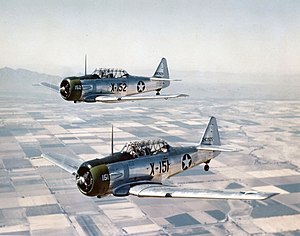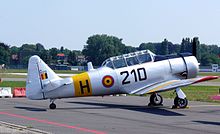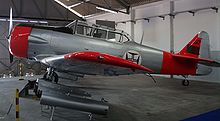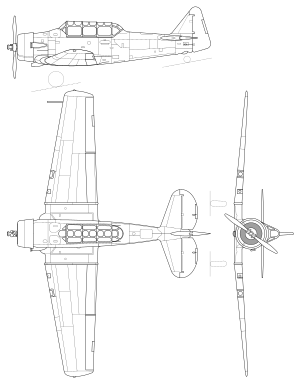

| T-6 Texan/SNJ/Harvard | |
|---|---|

| |
| USAAF AT-6Cs near Luke Field, 1943 | |
| Role | Trainer aircraft
Type of aircraft
|
| National origin | United States |
| Manufacturer | North American Aviation |
| First flight | 1 April 1935 |
| Retired | 1995 (South African Air Force) |
| Primary users | United States Army Air Forces United States Navy Royal Air Force Royal Canadian Air Force |
| Number built | 15,495 |
| Developed from | North American NA-16 |
| Variants | North American A-27 Bacon Super T-6 |
| Developed into | North American P-64 CAC Wirraway |
The North American Aviation T-6 Texan is an American single-engined advanced trainer aircraft used to train pilots of the United States Army Air Forces (USAAF), United States Air Force (USAF), United States Navy, Royal Air Force, Royal Canadian Air Force and other air forces of the British Commonwealth during World War II and into the 1970s. Designed by North American Aviation, the T-6 is known by a variety of designations depending on the model and operating air force. The United States Army Air Corps (USAAC) and USAAF designated it as the AT-6, the United States Navy the SNJ, and British Commonwealth air forces the Harvard, the name by which it is best known outside the US. Starting in 1948, the new United States Air Force (USAF) designated it the T-6, with the USN following in 1962. It remains a popular warbird used for airshow demonstrations and static displays. It has also been used many times to simulate various historical aircraft, including the Japanese Mitsubishi A6M Zero. A total of 15,495 T-6s of all variants were built.





The Texan's ancestry goes back to the North American NA-16 prototype which was first flown on 1 April 1935. In 1935, NAA submitted this design for the U.S. Army Air Corps Basic Trainer Competition. NAA also targeted the export market.[1]
Modified as the NA-26, it was submitted as an entry for a USAAC "Basic Combat Trainer " aircraft competition in March 1937. Based on the NA-18, but with a foot longer wingspan, it was the first of the NA-16 series with retractable gear. It was similar to the BT-9, but with a larger engine, the 550 hp (410 kW) Pratt & Whitney R-1340 Wasp, and could accommodate two .30 in (7.62 mm) guns.
With minor alterations, 177 unarmed NA-36s would enter service as the BC-1 with a R-1340-47 engine from 9 June 1937. Roughly 30 were modified as BC-1-I instrument trainers. The BC-1A (NA-55-1) followed as an armed version, primarily for Air Corps Reserve and National Guard units, and the 83 built could be equipped with a .30 in (7.62 mm) machine gun on the nose, and a flexible gun in the rear cockpit.
The US Navy received 40 NA-28 aircraft based on the BT-9, which it designated the NJ-1, as well as 16 NA-52s, designated the SNJ-1, 36 NA-65 as SNJ-2s, and 25 NA-79 also as SNJ-2s.[1]: 33–44, 214
In March 1937, the Commonwealth Aircraft Corporation of Australia purchased an NA-32 (NA-16-1A, with fixed undercarriage) and an NA-33 (NA-16-2K with retractible undercarriage) along with a manufacturing license. The first CAC Wirraway, based on the NA-33, flew on 27 March 1939, of which 755 were built.[1]: 52–53
In August 1937, Mitsubishi Jukogyo K.K. purchased a single NA-16, NA-16-4R (NA-37), powered by the 450 hp (340 kW) Pratt & Whitney R-985-9CG, including manufacturing rights. A second N-16, NA-16-4RW (NA-47), powered by a smaller Wright engine, was ordered in December 1937. After being evaluated by the Imperial Japanese Navy, Kyusu and K.K. Watanabe Tekkosho chose to ignore the NAA design almost entirely, and built 176 of the somewhat similar K10W1 from 1941 to 1942 which the Allies gave the code name Oak.[2] After WWII, the Japanese Air Self Defense Force operated 195 Texans (9 T-6Ds, 11 T-6Fs, and 175 T-6Gs) and the Japanese Maritime Self Defence Force operated 62 (10 SNJ-4s, 41 SNJ-5s, and 11 SNJ-6s)[1]: 56–57, 214
According to Dan Hagedorn, "the BC-1A series may be regarded as the true beginning of the modern AT-6 series." In December 1938, the British Commonwealth started receiving the first of 400 Harvard Mark Is (NA-49), for use in the Central Flying School. They were powered by the 600 hp (450 kW) Pratt & Whitney R-1340-S3H1 Wasp. In May 1939, the Royal Canadian Air Force (RCAF) ordered 30 Harvard Mark Is (NA-61). Then in November 1939, the British Purchasing Commission ordered the first of eventually 1275 Harvard Mark IIs (NA-66, NA-75, NA-76, and NA-81) for the Royal Air Force and RCAF.[1]: 46, 63–66, 69, 77–79, 92, 214
On 23 April 1939, NAA received a contract for 251 BT-14s and 94 AT-6s. The BT-14 (NA-58) was a fixed gear aircraft with a metal skinned fuselage 14 inches longer than the BT-9. In 1941, 27 BT-14s were refitted with the 400 hp (300 kW) R-985-11, and designated as BT-14A-NAs. In June 1939, NAA received an order for 94 AT-6-NAs (NA-59), powered by the wright R-1340-47 and able to mount two .30 in (7.62 mm) machines guns.[1]: 46–47, 73–74, 214
The USAAC AT-6A, and the U.S. Navy SNJ-3, were based on the NA-77 and NA-78 designs. Pratt & Whitney R-1340-49 Wasp radial engine powered the USAAC aircraft, while R-1340-38s powered the Navy aircraft. The USAAC received 1847 AT-6As, and the Navy received 270 SNJ-3s.[1]: 80–91, 214
The AT-6B (NA-84) was built for armament training, and could mount a .30 in (7.62 mm) machine gun on the right nose cowl, right wing, and in the rear cockpit, and could carry a light bomb rack. The aircraft was powered by the 600 hp (450 kW) R-1340-AN-1 engine. The USAAC received 400.[1]: 93–97, 214
The NA-88 design was used to build 2970 AT-6Cs (747 of which went to the British Commonwealth as Harvard IIas), 2401 SNJ-4s, 2604 AT-6Ds (537 of which went to the British Commonwealth as Harvard IIIs), and 1357 SNJ-5s. The first AT-6C aircraft was delivered on 12 February 1942. The 12-volt electrical system was changed to a 24-volt system in the AT-6D, for standardization amongst the service. The AT-6D, which was also armament capable, and early versions included a wing gun camera, and a high-pressure oxygen system. The AT-6D used two toggle starter switches, rather than the foot pedal starter, and the first AT-6D was delivered on 22 July 1943. The Navy received an additional 630 AT-6Ds direct from the USAAF, redesignating them SNJ-5s, for a total of 1987. Similarly, the NA-121 design was used to build the final wartime Texans, and included 800 AT-6Ds (of which 211 went to the Navy as SNJ-5s), and 956 AT-6Fs (of which 411 went to the Navy as SNJ-6s). They were capable of carrying a 20 US gal (76 L; 17 imp gal) centerline drop tank.[1]: 98–128, 214
From 1942, Canada's Noorduyn built 2557 R-1340-AN-1-powered Harvard IIs under license, paid for by USAAF Lend-Lease funds as the AT-16, but designated as the Harvard II.B. After WWII, many remained in service with the RCAF.[1]: 122–124
The NA-168 series consisted of remanufactured AT-6s and SNJs for the USAF, starting in 1949. The Air Training Command received 641 aircraft, designated T-6G-NT, of which 416 eventually were sent to U.S. Military Assistance Program countries. U.S. National Guard units received an additional 50 aircraft, of which 28 eventually were sent to France. An additional 59 aircraft were Liaison/Trainer aircraft, designated LT-6G-NA, for the Korean War. These aircraft could be deployed with 2 detachable .30 in (7.62 mm) machine gun pods, and 4 HVARs, or 4 100 lb (45 kg) bombs, plus a 55 US gal (210 L; 46 imp gal) auxiliary drop tank. Alternatively, they could carry the gun pods and 12 2.25 in (57 mm) SCA markings rockets, or 6 100 lb (45 kg) bombs. The T-6G-NAs had a 140 US gal (530 L; 120 imp gal) fuel capacity, while previous models had a 110 US gal (420 L; 92 imp gal) capacity. The rear cockpit also had the same instruments as the front cockpit. Then, in 1951, the USAF placed an order for 824 T-6Gs, designated T-6G-1-NH, for the Air Training Command.[1]: 139–153, 214
The Canada Car and Foundry built 285 Harvard 4s, designated NA-186 under the Mutual Defense Assistance Program (MDAP) and an additional 270 directly for the RCAF.[1]: 153–154
In April 1951, the USAF ordered an additional 107 T-6Gs for the MDAP, designated NA-188. They placed an order for 11 training aircraft in March 1952, designated NA-195, and then a final batch of 110 aircraft in June for MDAP, designated NA-197.[1]: 155–159, 214

The aircraft was mainly used for training, however in many cases it was also repurposed into combat roles. The aircraft served in a great many air forces around the world in the mid to late 20th century. After serving in air forces, it also went on to be displayed at air shows and museums as a warbird.
The British used Harvards during World War II in North Africa, but not in a combat role. They were used extensively for preparing pilots in theatre for flying US aircraft types, whose handling and controls differed from British aircraft.
No. 74 Operational Training Unit (OTU) was formed at RAF Aqir in Palestine from ‘C’ Flight of 71 OTU who made various moves to Rayak in July 1942, Muqeibila in November 1942, and back to Aqir in February 1943. The RAF later handed over control to No. 203 Group RAF in May 1943. The unit disbanded in July 1945. Harvard AJ841 "Wacky Wabbit" – AJ 841 saw service with No. 154 Squadron RAF. Originally 154 Squadron were based just at RAF Fowlmere before they were deployed to the Middle East in 1942. Record cards for 154 Squadron show the squadron Harvard being flown by Flying Officer DC Dunn from Minnigh (Syria) to Ramat David (Palestine) on 12 February 1944.

Peru used its seven T-6 fighter bombers in the Ecuadorian-Peruvian War equipped with two 7.65 mm (0.30 in) guns, while carrying up to four 116 lb (53 kg) bombs.[1]: 176–178 Twenty AT-6s were employed by the 1st and 2nd fighter squadrons of the Syrian Air Force in the 1948 Arab-Israeli War, providing ground support for Syrian troops, and launching airstrikes against Israeli airfields, ships, and columns, losing one aircraft to antiaircraft fire. They also engaged in air-to-air combat on a number of occasions, with a rear gunner shooting down an Israeli Avia S-199 fighter.[3]
The Israeli Air Force (IAF) bought 17 Harvards, and operated nine of them in the final stages of the 1948 Arab-Israeli War, against the Egyptian ground forces, with no losses. In the Sinai Campaign, IAF Harvards attacked Egyptian ground forces in Sinai Peninsula with two losses.


The Royal Hellenic Air Force employed three squadrons of British- and American-supplied T-6D and G Texans for close air support, observation, and artillery spotting duties during the Greek Civil War, providing extensive support to the Greek army during the Battle of Gramos. Communist guerillas called these aircraft "O Galatas" ("The Milkman"), because they saw them flying very early in the morning. After the "Milkmen", the guerillas waited for the armed Spitfires and Helldivers.
During the Korean War and, to a lesser extent, the Vietnam War, T-6s were pressed into service as forward air control aircraft. These aircraft were designated T-6 "Mosquitos".[4][5][1]: 148–151
No. 1340 Flight RAF used the Harvard in Kenya against the Mau Mau in the 1950s, where they operated with 20 lb (9.1 kg) bombs and machine guns against the rebels. Some operations took place at altitudes around 20,000 ft (6,100 m) above mean sea level. A Harvard was the longest-serving RAF aircraft, with an example, taken on strength in 1945, still serving in the 1990s (as a chase plane for helicopter test flights—a role for which the Shorts Tucano's higher stall speed was ill-suited).
The T-6G was also used in a light attack or counterinsurgency role by France during the Algerian War in special Escadrilles d'Aviation Légère d'Appui (EALA), armed with machine guns, bombs and rockets. At its peak, 38 EALAs were active. The largest unit was the Groupe d'Aviation Légère d'Appui 72, which consisted of up to 21 EALAs.
From 1961 to 1975, Portugal used more than a hundred T-6Gs, also in the counterinsurgency role, during the Portuguese Colonial War. During this war, almost all the Portuguese Air Force bases and air fields in Angola, Mozambique, and Portuguese Guinea had a detachment of T-6Gs.
On 16 June 1955, rebel Argentine Navy SNJ-4s bombed Plaza de Mayo in Buenos Aires, Argentina; one was shot down by a loyalist Gloster Meteor. Navy SNJ-4s were later used by the colorado rebels in the 1963 Argentine Navy Revolt, launching attacks on the 8th Tank Regiment columns on 2 and 3 April, knocking out several M4 Sherman tanks, and losing one SNJ to anti-aircraft fire.[6]
In 1957–58, the Spanish Air Force used T-6s as counterinsurgency aircraft in the Ifni War, armed with machine guns, iron bombs, and rockets, achieving an excellent reputation due to its reliability, safety record, and resistance to damage.
The Pakistan Air Force used T-6Gs in the Indo-Pakistani War of 1971 as a night ground-support aircraft, hitting soft transport vehicles of the Indian army. In the early hours of 5 December, during a convoy interdiction mission in the same area, Squadron Leader Israr Quresh's T-6G Harvard was hit by Indian antiaircraft ground fire and a shell fractured the pilot's right arm. Profusely bleeding, the pilot flew the aircraft back with his left hand and landed safely. The World War II-vintage propellered trainers were pressed into service and performed satisfactorily in the assigned role of convoy escorts at night.
The South African Air Force received their first T-6s in October 1942 to be used by the Joint Air Training Scheme. By July 1944, 633 Harvard Mk IIA T-6s and IIIs had been shipped to South Africa with another 555 (379 MkIIAs and 176 Mk IIIs) to arrive by October 1945. Another 65 (AT-6Ds and 30 T-6Gs) were ordered between 1952 and 1956.[7] The aircraft also saw some action during the South African Border war. The T-6 remained in service until 1995 as a basic trainer, mainly as a result of the United Nations arms embargo against South Africa's apartheid policies. They were replaced by Pilatus PC-7 MkII turboprop trainers.[8]
The Harvard 4 has been used in Canada as a testbed aircraft for evaluating cockpit attitude displays. Its aerobatic capability permits the instructor pilot to maneuver the aircraft into unusual attitudes, then turn the craft over to an evaluator pilot in the "blind" rear cockpit to recover, based on one of several digitally generated attitude displays.[9]













Data from Jane's Fighting Aircraft of World War II.[20]
General characteristics
Performance
Armament


In the September 1944 issue of The Sportsman Pilot, USAAF Capt. Paul K. Jones' article stated, "The Six is a plane that can do anything a fighter can do—and even more. Naturally not as fast, she makes up for speed in her ease of handling and her maneuverability. She's a war machine, yes, but more than that she's a flyer's airplane. Rolls, Immelmans, loops, spins, snaps, vertical rolls—she can do anything—and do it beautifully. For actual combat, more guns, more speed and more power is needed. But for the sheer joy of flying—give me an AT-6."[1]: 8–9
After World War II, the National Air Races established a unique racing class for the AT-6/Texan/Harvard aircraft; this class continues today at the Reno National Air Races each year.
Since the Second World War, the T-6 has been a regular participant at air shows, and was used in many movies and television programs. For example, converted single-seat T-6s painted in Japanese markings to represent Mitsubishi Zeros made appearances in A Yank in the R.A.F. (1941), Tora! Tora! Tora! (1970), Baa Baa Black Sheep (1976-1978), and The Final Countdown (1980). In A Bridge too Far (1977) it represented the razorback Republic P-47 Thunderbolt. Some were modified for the Dutch film Soldaat van Oranje (1977) to represent the Dutch pre–World War II fighter Fokker D.XXI.
The T-6 had a major role in the Pat Benatar music video for the song "Shadows of the Night". It was also used for a backdrop on the album cover of the 1978 Black Sabbath album Never Say Die!
The New Zealand Warbirds "Roaring 40s" aerobatic team use ex–Royal New Zealand Air Force Harvards. The Flying Lions Aerobatic Team uses Harvards acquired from the South African Air Force.[21]
Related development
Aircraft of comparable role, configuration, and era
Related lists
| National |
|
|---|---|
| Other |
|